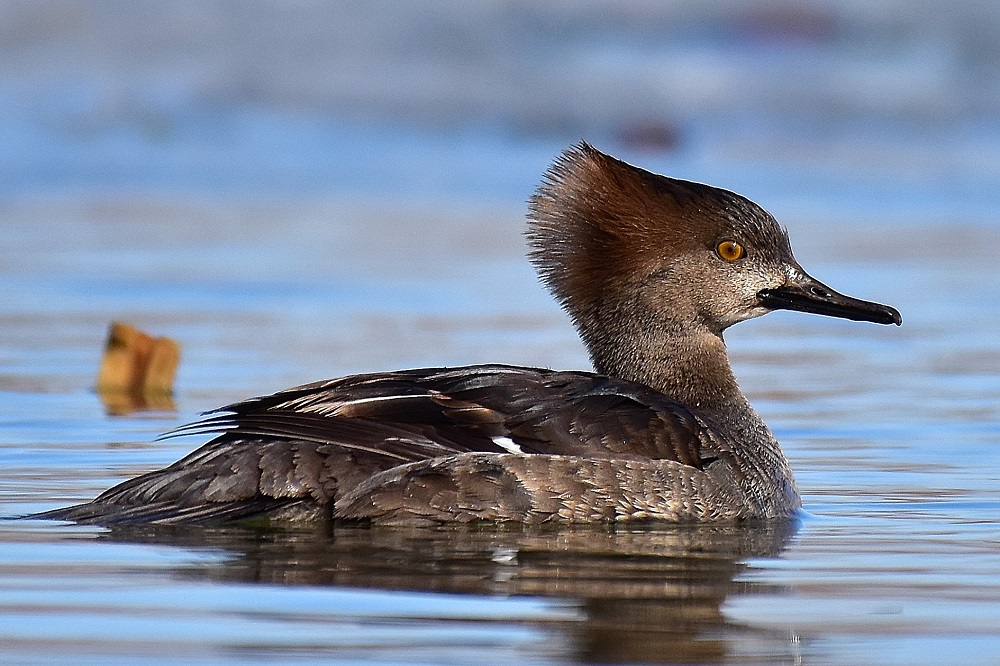
Photo by Kevin Wright.



Photo by Kevin Wright.
Centrally located in the Mississippi Flyway, Illinois hosts thousands of waterfowl during fall and spring migrations. Among the waterfowl that grace the state’s waterways, mergansers can frequently be seen resting and feeding on rivers, lakes, ponds, and wetlands. Three merganser species—hooded, common and red-breasted—can be found in Illinois at certain times of year, each with a distinct plumage and behavior.
All three species of mergansers can be hunted in Illinois, and populations are generally stable, according to the Cornell Lab of Ornithology. Mergansers typically eat fish, which can make their meat less palatable to many human consumers compared to the mallard, a dabbling duck that eats mostly vegetation, seeds, nuts and invertebrates. Still, some hunters have special recipes for making a merganser tasty. Of the three, the species coveted most by hunters is the hooded merganser, due to its striking plumage. A mature adult male hooded merganser can be considered a trophy worthy of taxidermy.

Meanwhile, nature enthusiasts love watching mergansers, especially in winter and early spring when they put on fascinating courtship displays. For example, a male common merganser spins in circles near the female and then stretches his head high and points his bill upward while softly vocalizing.
Merganser species have long, thin, serrated bills that help them grasp and hold onto slippery fish, their most often sought-after prey. Male and female plumages of each species are quite different, as are adults and juveniles. Immature mergansers often look more like the females.
The hooded merganser is the smallest of the three species, measuring 16 inches long with a 24-inch-wide wingspan. Adult males have black backs, a white breast and chestnut sides. The male’s head is black with a striking large, white crest, which can be raised or lowered. The female is brownish overall and has a reddish-brown crest with none of the fancy coloration of the male. When flying, both males and females have white wing patches. Having a more varied diet than other merganser species, the hooded not only eats fish, but also aquatic insects, crustaceans, amphibians, mollusks and even some plant materials.

During migration and winter, hooded mergansers frequent rivers, reservoirs, lakes and ponds in Illinois. In summer, hooded mergansers breed in forested wetlands including swamps and sloughs. The female lays 10-12 white eggs in a tree cavity or human-made box. Sometimes she lays her eggs in another duck nest cavity, such as a wood duck or another hooded merganser. She also protects her young from predators, such as raccoons and woodpeckers that might steal eggs or nestlings, by faking a broken wing. After incubating the eggs for about a month, they hatch. Nature enthusiasts likely know that wood duck nestlings jump out of a nest cavity just minutes after they are hatched. Hooded merganser nestlings do the same, coached by their mother from the ground. It takes another couple of months before the young can fly.

The common merganser is a hardier merganser species. During Illinois winters, they can often be seen swimming in small rafts in open water, like on Lake Michigan. The common merganser is 22 to 27 inches long with a 34-inch-wide wingspan. The male sports a dark green head contrasted with a red bill. His neck, sides and belly are white, and his back is dark. The female has a rufous-colored neck, shaggy head and a gray body with a white chin and breast. Like other ducks that dive for food, the common merganser has to run along the water’s surface and beat its wings rapidly to become airborne. In flight, common mergansers show off white upper wing patches. A common migrant and winter resident in Illinois, this merganser species nests in the Canadian boreal zone and mountainous regions of western United States.
Common mergansers dive to 30 feet below the water’s surface to snatch small salmon, trout, carp, shad, perch and sunfish. They will also opportunistically eat frogs, birds and small mammals. During migration and in winter, common mergansers can be found on large lakes, reservoirs and rivers with open water in the state. Some key spots include Lake Michigan, Heidecke Lake, LaSalle Lake, the Mississippi River and the Illinois River.

The red-breasted merganser is a common Illinois migrant and somewhat common winter resident. Found mostly on Lake Michigan and some downstate reservoirs and lakes, they congregate where fish, minnows and shrimp are plentiful. Sometimes this merganser species gathers in small groups to herd prey for easier hunting. The red-breasted merganser is 19 to 26 inches long with a wingspan of about 30 inches. The male has a shaggy, wispy crest emanating from its green head, a long thin reddish bill, a white band around its neck and a rufous chest with black markings.

The female has a shaggy reddish-brown crest and is brownish-gray overall. Red-breasted mergansers nests even farther north than the common merganser, in areas including Arctic Canada, Alaska and Greenland. One successful nesting of the red-breasted merganser has been documented in Illinois.
Merganser hunting dates and bag limits in Illinois vary depending on the part of state, with some in late October and others running through late January.
When the fall winds start blowing, dress warmly and head out to the water to search for common, hooded and red-breasted mergansers. Return later in winter to observe them courting before they head north to breed.
Sheryl DeVore writes environment and nature pieces for regional and national publications and has had several books published, including “Birds of Illinois” co-authored with her husband, Steven D. Bailey.
Submit a question for the author